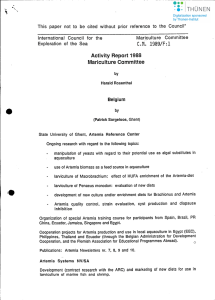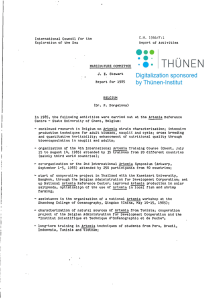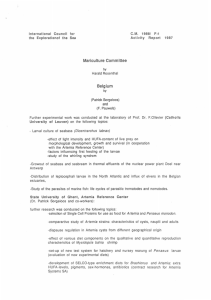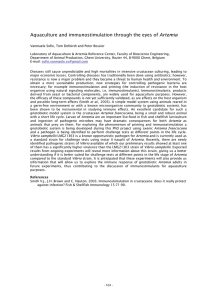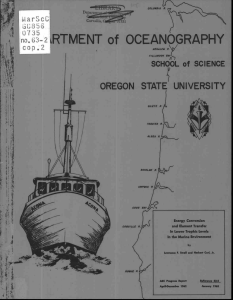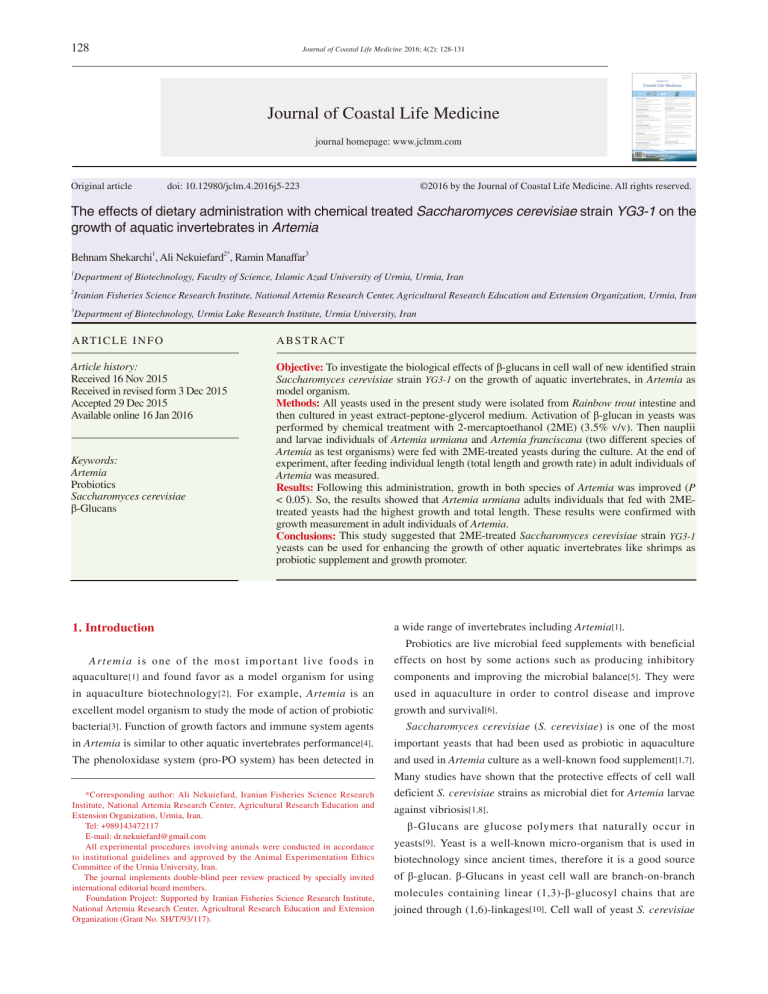
128
Journal of Coastal Life Medicine 2016; 4(2): 128-131
Journal of Coastal Life Medicine
journal homepage: www.jclmm.com
Original article
doi: 10.12980/jclm.4.2016j5-223
©2016 by the Journal of Coastal Life Medicine. All rights reserved.
The effects of dietary administration with chemical treated Saccharomyces cerevisiae strain YG3-1 on the
growth of aquatic invertebrates in Artemia
Behnam Shekarchi1, Ali Nekuiefard2*, Ramin Manaffar3
1
Department of Biotechnology, Faculty of Science, Islamic Azad University of Urmia, Urmia, Iran
2
Iranian Fisheries Science Research Institute, National Artemia Research Center, Agricultural Research Education and Extension Organization, Urmia, Iran
3
Department of Biotechnology, Urmia Lake Research Institute, Urmia University, Iran
A RT I C L E I N F O
A B S T R AC T
Article history:
Received 16 Nov 2015
Received in revised form 3 Dec 2015
Accepted 29 Dec 2015
Available online 16 Jan 2016
Objective: To investigate the biological effects of β-glucans in cell wall of new identified strain
Saccharomyces cerevisiae strain YG3-1 on the growth of aquatic invertebrates, in Artemia as
model organism.
Methods: All yeasts used in the present study were isolated from Rainbow trout intestine and
then cultured in yeast extract-peptone-glycerol medium. Activation of β-glucan in yeasts was
performed by chemical treatment with 2-mercaptoethanol (2ME) (3.5% v/v). Then nauplii
and larvae individuals of Artemia urmiana and Artemia franciscana (two different species of
Artemia as test organisms) were fed with 2ME-treated yeasts during the culture. At the end of
experiment, after feeding individual length (total length and growth rate) in adult individuals of
Artemia was measured.
Results: Following this administration, growth in both species of Artemia was improved (P
< 0.05). So, the results showed that Artemia urmiana adults individuals that fed with 2MEtreated yeasts had the highest growth and total length. These results were confirmed with
growth measurement in adult individuals of Artemia.
Conclusions: This study suggested that 2ME-treated Saccharomyces cerevisiae strain YG3-1
yeasts can be used for enhancing the growth of other aquatic invertebrates like shrimps as
probiotic supplement and growth promoter.
Keywords:
Artemia
Probiotics
Saccharomyces cerevisiae
β-Glucans
1. Introduction
a wide range of invertebrates including Artemia[1].
Artemia is one of the most important live foods in
aquaculture [1] and found favor as a model organism for using
effects on host by some actions such as producing inhibitory
components and improving the microbial balance[5]. They were
in aquaculture biotechnology [2] . For example, Artemia is an
used in aquaculture in order to control disease and improve
excellent model organism to study the mode of action of probiotic
growth and survival[6].
Probiotics are live microbial feed supplements with beneficial
bacteria[3]. Function of growth factors and immune system agents
Saccharomyces cerevisiae (S. cerevisiae) is one of the most
in Artemia is similar to other aquatic invertebrates performance[4].
important yeasts that had been used as probiotic in aquaculture
The phenoloxidase system (pro-PO system) has been detected in
and used in Artemia culture as a well-known food supplement[1,7].
Many studies have shown that the protective effects of cell wall
*Corresponding author: Ali Nekuiefard, Iranian Fisheries Science Research
Institute, National Artemia Research Center, Agricultural Research Education and
Extension Organization, Urmia, Iran.
Tel: +989143472117
E-mail: dr.nekuiefard@gmail.com
All experimental procedures involving animals were conducted in accordance
to institutional guidelines and approved by the Animal Experimentation Ethics
Committee of the Urmia University, Iran.
The journal implements double-blind peer review practiced by specially invited
international editorial board members.
Foundation Project: Supported by Iranian Fisheries Science Research Institute,
National Artemia Research Center, Agricultural Research Education and Extension
Organization (Grant No. SH/T/93/117).
deficient S. cerevisiae strains as microbial diet for Artemia larvae
against vibriosis[1,8].
β-Glucans are glucose polymers that naturally occur in
yeasts[9]. Yeast is a well-known micro-organism that is used in
biotechnology since ancient times, therefore it is a good source
of β-glucan. β-Glucans in yeast cell wall are branch-on-branch
molecules containing linear (1,3)-β-glucosyl chains that are
joined through (1,6)-linkages[10]. Cell wall of yeast S. cerevisiae
129
Behnam Shekarchi et al./Journal of Coastal Life Medicine 2016; 4(2): 128-131
is one of the most common sources of β-1,3/1,6-glucan[11]. Yeast
incubated in artificial 0.45 μm filtered medium with salinity at
β-glucan is located under the manno-protein layer of yeast cell
35 g/L. After hatching, 500 individuals of instar-I nauplii were
wall. So, applying the chemical treatment for activation and
transferred directly into the 1 cylindroconical vials at an initial
increasing the bioavailability of β-glucan is necessary. Yeast
density of 2 nauplii/mL of 80 g/L culture medium. Finally, based
β-glucan can stimulate the immune system of animals including
on the standard protocol, culture was performed in two treatments
the aquatic invertebrates. S. cerevisiae β-glucan could improve the
and four replicates for each treatment[16,17]. During the culture,
immune system function and growth in aquatic invertebrates such
both species of Artemia [Artemia urmiana (A. urmiana) and
as Artemia by affecting on some immune system particles and
Artemia franciscana (A. franciscana)] fed with two forms of yeast
growth factors along with chitin, another polysaccharide structure
S. cerevisiae YG3-1: 1) Whole cell yeast without any treatment
in the yeast cell wall [8] . Also, physiological, nutritional and
(as control treatment); 2) 2ME-treated yeast (as β-glucan
immunological role of dietary β-1-3 glucan had been studied in
treatment), plus Dunaliella tertiolecta algae, for evaluation of
Litopenaeus vannamei (Whiteleg shrimp) juveniles[12]. However,
biological effects of β-glucan in cell wall of new strain yeast
the effect of 2-mercaptoethanol (2ME)-treated S. cerevisiae YG3-1
(S. cerevisiae strain YG3-1) on the growth of Artemia. Feeding
on the growth of Artemia and other aquatic invertebrates has not
was performed according to the Coutteau et al.[15] feeding table.
been studied by now.
Air during culturing was passed through a 0.22 μm filter. At the
The purpose of this study was to investigate the biological
end of the expreiment, after feeding to determine the effect of
effects of β-glucans in cell wall of new identified strain S.
β-glucan on the growth of Artemia, their individual length was
cerevisiae strain YG3-1 on the growth of aquatic invertebrates, in
measured according to the procedure described by Marques
Artemia as model organism.
et al. [3] with using a dissecting microscope equipped with a
drawing mirror on Days 3, 7, 11 and 15 of experiment. Values of
2. Materials and methods
individual length and total length were logarithmic transformed
or square root transformed to satisfy normal distribution and
2.1. Preparation of S. cerevisiae YG3-1 as probiotic yeast
homocedasticity requirements. All treatments were applied based
on the standard protocols that adapted from previous literatures.
All of yeasts used in the present study were isolated from
However, considering the lack of pain feel system in crustaceans,
intestine of farmed endemic Rainbow trout belonging to the
sampling for chemical treatment was applied with minimal
Western Azerbaijan State of Iran according to the procedure
samples. Individual length and total length of Artemia fed with
described by Andlid et al.[13] and then identified by molecular
different feeds were investigated with ANOVA and with multiple
methods.
comparisons Tukey’s range. One-way ANOVA and Duncan’s test
2.2. Activation and enhancement of the bioavailability of
β-glucan in S. cerevisiae cell wall
means. Significances were accepted at P < 0.05, according to the
of SPSS 16 software were used to identify differences among
For this purpose, yeasts were cultured and grown using by yeast
procedure of Baxevanis et al.[18].
3. Results
extract-peptone-glycerol medium. In the stationary growth phase
(after 3 days) yeast cells were harvested by centrifugation (5 000 r/
Results of growth measurement indicated that at the parameter
min for 10 min)[14]. Then, harvested yeasts were divided into two
of total length, feeding with 2ME-treated S. cerevisiae YG3-1
groups and stored at -20 °C. After that chemical (2ME) treatment
(without the mannoprotein and contains bioactive β-glucan)
was applied on the one group of yeast cells. In this way, yeast cells
resulted in the maximum rate of growth in both species of
were suspended at a concentration of 200 mg/mL wet weight in
Artemia. The maximum total length of Artemia was significantly
a sterilized medium containing Na2EDTA (0.05 mol/L) and Tris-
obtained from the A. urmiana (Tables 1 and 2) (P < 0.05).
buffer (0.2 mol/L) with pH = 8. After addition of 2ME (3.5% v/
v), the yeast cells were incubated for 60 min at 30 °C on a shaker.
Pretreated yeasts were collected and washed with protoplasting
medium comprising a phosphate-citrate buffer (KH2PO4 0.08 mol/
L, Na3citrate 0.016 mol/L; pH = 5.8) and KCl (0.6 mol/L). Finally,
yeast cells were washed twice with NaCl 9% and then stored at 4
°C
until the end of experiment[5,15].
2.3. Artemia culture, feeding and growth measurement
For optimal hatching, 1.5 g cysts of the each population were
Table 1
Total length of A. franciscana.
Treatment
Control
β-Glucan
Day 3
1.30 ± 0.21a
1.46 ± 0.17b
Day 7
2.77 ± 0.76a
0.63 ± 2.97c
Day 11
3.87 ± 0.47a
0.59 ± 3.67c
Day 15
7.55 ± 0.84a
1.14 ± 7.69b
Different letters in each column indicate significant differentiation.
Table 2
Total length of A. urmiana.
Treatment
Control
β-Glucan
Day 3
1.29 ± 0.17a
1.35 ± 0.19c
Day 7
2.65 ± 0.52a
0.74 ± 2.85b
Day 11
3.73 ± 0.63a
0.57 ± 4.93c
Day 15
8.12 ± 1.70a
1.84 ± 8.37c
Different letters in each column indicate significant differentiation.
130
Behnam Shekarchi et al./Journal of Coastal Life Medicine 2016; 4(2): 128-131
4. Discussion
aquatic invertebrates. Effect of dietary carbohydrate on the growth
of prawn was reported by Abdel-Rahman et al.[21]. Also, influence
In the present study the dietary administration with S. cerevisiae
of dietary carbohydrate on the metabolism of juvenile Litopenaeus
strain YG3-1 in two forms improved the growth in A. urmiana and
stylirostris was studied by Rosas et al. [22]. Effects of dietary
A. franciscana. As shown in this study, the highest growth rate
mannan oligosaccharide on growth performance of juvenile Pacific
was shown in 2ME-treated yeast group (without the mannoprotein
white shrimp, Litopenaeus vannamei, were also determined by
and contains bioactive β-glucan). Treatment with 2ME results to
Zhang et al.[23]. In addition, Andrino et al.[24] showed that shrimps
the possibility facilitating the action of the digestive enzymes on
fed with mannan oligosaccharide and β-glucan supplemented diets
the yeast biomass by breaking of disulphide linkages between the
have significantly higher % weight gain than those fed the control
mannoprotein molecules of the yeast cell wall and giving rise to a
diet. Besides, the synergistic effects of β-glucan and mannan
more open structure in the cell wall. Furthermore, this treatment
oligosaccharide on growth performance of sea cucumber were
resulted in more efficient affecting of β-glucan. Before this, dietary
reported by Gu et al.[25]. However, some authors claim that the
administration of ME treated S. cerevisiae has been used for
β-(1→3),(1→6)-glucan derived from yeast S. cerevisiae produce
enhancing the growth, function of immune system, survival and
the highest biological effects[9].
resistance of aquatic animals in stress conditions[5]. But the effect
β-Glucans were reported to growth promotion, enhance non-
of 2ME-treated S. cerevisiae YG3-1 on the performance of aquatic
specific immune responses and disease resistance. According to
animals including aquatic invertebrates like Artemia has not been
the Soltanian et al.[8], β-glucan can improve the immune system
studied by now.
function and growth in aquatic invertebrates such as Artemia by
In many studies, a wide range of micro-organisms have been used
affecting on some immune system particles and growth factors. Due
as probiotics for enhancing the growth of aquatic animals[19,20].
to biological effects of β-glucan and chemical treatment with 2ME,
Among them, yeasts are particularly interesting because they
feeding with 2ME-treated S. cerevisiae YG3-1 yeasts (without the
provide β-glucan and nucleotides that stimulate the immune system
mannoprotein and contains bioactive β-glucan) could enhance the
of aquatic animals[6]. In this study, new identified yeast S. cerevisiae
growth in Artemia. In this study, bioactive β-glucans of cell wall of
YG3-1 was used. Also, deficient cell wall S. cerevisiae strains have
S. cerevisiae strain YG3-1 might enhance the function of immune
been reported to have promoting effects on the growth of aquatic
system particles and growth factors in Artemia.
invertebrates including Artemia. Soltanian et al.[8] showed that
The purpose of this study was to determine the biological effects
feeding Artemia with isogenic mutant strains of baker’s yeast has
of β-glucans of cell wall of S. cerevisiae strain YG3-1 on the
a big influence on the growth of Artemia. Results of their study
growth of aquaqtic invertebrates. So, these claimed effects were
were showed that compared with wild type yeast, total biomass
evaluated in Artemia as model organism with using by a dietary
production of nauplii was significantly improved when the isogenic
administration. At the present study, the effects of S. cerevisiae
yeast mutant strains were used as feed, due to both significant
YG3-1 β-glucans on the growth promotion were agreed. This study
higher survival and/or individual length. In the present study, as
indicates that 2ME-treated S. cerevisiae YG3-1 yeast has probiotic
earlier mentioned dietary administration with 2ME-treated S.
properties and can promote the growth of aquatic invertebrates.
cerevisiae strain YG3-1 improved the growth of Artemia. This result
Also, obtained results of this study suggest that S. cerevisiae YG3-1
maybe was obtained due to a considerable increase in survival of
yeasts (specially 2ME-treated yeasts) can be used for enhancing the
Artemia. Moreover, influence of yeast quality on performance of
growth of other aquatic invertebrates such as shrimps as probiotic
gnotobiotically grown Artemia was studied by Marques et
supplement.
al.[3].
In their study, only in five out of eight experiments, higher total
biomass production was obtained when exponentially grown
Conflict of interest statement
yeast cells were fed to Artemia compared to nauplii fed stationary
phase grown cells. At the present study, feeding with 2ME-
We declare that we have no conflict of interest.
treated stationary phase grown S. cerevisiae YG3-1 (without the
mannoprotein and contains bioactive β-glucan) resulted in the
Acknowledgments
maximum rate of growth in both species of Artemia. It is worth
mentioning that isogenic mutant strains (deficient cell wall yeasts
This study was supported by Iranian Fisheries Science Research
with genetic background) of baker’s yeast (S. cerevisiae) were used
Institute, National Artemia Research Center, Agricultural Research
in both study mentioned above. While, all of yeasts that were used
Education and Extension Organization (Grant No. SH/T/93/117).
in the present study were wild type yeasts that were treated with
Also, we thank people in National Artemia Research Center and
chemical treatment.
Urmia Lake Research Institute at Urmia, Iran, for their help and
Many carbohydrates were reported to growth promotion in
advice.
Behnam Shekarchi et al./Journal of Coastal Life Medicine 2016; 4(2): 128-131
References
131
juveniles. Aquaculture 2003; 224: 223-43.
[13] Andlid T, Juárez RV, Gustafsson L. Yeast colonization the intestine of
[1] Rojas-Garcia CR, Hasanuzzaman AFM, Sorgeloos P, Bossier P. Cell
wall deficient Saccharomyces cerevisiae strains as microbial diet for
Artemia larvae: protective effects against vibriosis and participation of
phenoloxidase. J Exp Mar Biol Ecol 2008; 360: 1-8.
[2] Gavanda MR, McClintocka JB, Amslera CD, Petersb RW, Angusa RA.
Effects of sonication and advanced chemical oxidants on the unicellular
rainbow trout (Salmo gairdneri) and turbot (Scophtalmus maximus).
Microb Ecol 1995; 30: 321-34.
[14] Aoki H, Miyamoto N, Furuya Y, Mankura M, Endo Y, Fujimoto K.
Incorporation and accumulation of docosahexaenoic acid from the
medium by Pichia methanolica HA-32. Biosci, Biotechnol Biochem
2002; 66: 2632-8.
green alga Dunaliella tertiolecta and cysts, larvae and adults of the
[15] C outteau P, Lavens P, Sorgeloos P. Baker’s yeast as a potential
brine shrimp Artemia salina: a prospective treatment to eradicate
substitute for live algae in aquaculture diets: Artemia as a case study. J
invasive organisms from ballast water. Mar Pollut Bull 2007; 54: 1777-
World Aquac Soc 1990; 21: 1-9.
88.
[16] S ankian Z, Heydari R, Manaffar R. Expression of 90 KDa heat
[3] Marques A, François JM, Dhonta J, Bossiera P, Sorgeloosa P. Influence
shock proteins in the brine shrimp Artemia Leach, 1819 (Crustacean:
of yeast quality on performance of gnotobiotically grown Artemia. J
Anostraca) in response to high salinity stress. Int J Artemia Biol 2011;
Exp Mar Biol Ecol 2004; 310: 247-64.
1: 3-12.
[4] Soltanian S. Protection of gnotobiotic Artemia against Vibrio campbellii
[17] Van Stappen G. Artemia. In: Lavens P, Sorgeloos P, editors. Manual on
using baker’s yeast strains and extracts [dissertation]. Kortrijk: Ghent
the production and use of live food for aquaculture. Ghent: Aquaculture
University; 2007.
and Artemia Reference Center, University of Ghent; 1996, p. 101-318.
[5] Tukmechi A, Rahmati Andani HR, Manaffar R, Sheikhzadeh N.
[18] Baxevanis AD, El-Bermawi N, Abatzopoulos TJ, Sorgeloos P. Salinity
Dietary administration of beta-mercapto-ethanol treated Saccharomyces
effects on maturation, reproductive and life span characteristics of
cerevisiae enhanced the growth, innate immune response and disease
four Egyptian Artemia populations (International Study on Artemia.
resistance of the rainbow trout, Onchorhynchus mykiss. Fish Shellfish
Immunol 2011; 30: 923-8.
[6] Mozhdeh N, Mehdi Y, Reza S, Milad N. The influence probiotic of
aqualase on the survival, growth, intestinal microflora and challenge
infection in wild carp (Cyprinius carpio L.). Res J Fish Hydrobiol
2010; 5(2): 168-72.
[7] R oman H. Development of yeast as an experimental organism in
the molecular and cellular biology of the yeast saccharomyces. In:
LXVIII). Hydrobiologia 2004; 513: 87-100.
[19] Soundarapandian P, Ramanan V, Dinakaran GK. Effect of probiotics on
the growth and survival of Penaeus monodon (Fabricius). Curr Res J
Soc Sci 2010; 2(2): 51-7.
[20] M ohammadi H, Agh N, Tukmechi A, Noori F. [Effects of using
Lactobacillus rhamnosus probiotic and Nigella sativa (black seed) on
the growth parameters of rainbow trout (Oncorhynchus mykiss)]. J Appl
Biol 2012; 24(1): 50-62. Persian.
Strathern JN, Jones EW, Broach JR, editors. The molecular biology of
[21] Abdel-Rahman SH, Akio Kanazawa A, Teshima S. Effects of dietary
the yeast Saccharomyces: life cycle and inheritance. New York: Cold
carbohydrate on the growth and the levels of the hepatopancreatic
Springer Press; 1981, p. 1-9.
glycogen and serum glucose of prawn. Bull Jap Soc Sci Fish 1979;
[8] Soltanian S, Dhont J, Sorgelooos P, Bossier P. Influence of different
45(12): 1491-4.
yeast cell-wall mutants on performance and protection against
[22] Rosas C, Cuzon G, Gaxiola G, Arena L, Lemaire P, Soyez C, et al.
pathogenic bacteria (Vibrio campbellii) in gnotobiotically-grown
Influence of dietary carbohydrate on the metabolism of juvenile
Artemia. Fish Shellfish Immunol 2007; 23: 141-53.
[9] Tominac-Petravić V, Zechner-Krpan V, Grba S, Srečec S, Panjkota-
Litopenaeus stylirostris. J Exp Mar Biol Ecol 2000; 249: 181-98.
[23] Zhang J, Liu Y, Tian L, Yang H, Liang G, Xu D. Effects of dietary
KrbavčićI, Vidović L. Biological effects of yeast β-glucans. Agric
mannan oligosaccharide on growth performance, gut morphology
Conspectus Sci 2010; 75: 149-58.
and stress tolerance of juvenile Pacific white shrimp, Litopenaeus
[10] Tam TM, Duy NQ, Minh NP, Anh Dao DT. Optimization of beta-
vannamei. Fish Shellfish Immunol 2012; 33: 1027-32.
glucan extraction from waste brewer’s yeast Saccharomyces cerevisiae
[24] Andrino KGS, Apines-Amar MJS, Janeo RL, Corre VL Jr. Effects
using autolysis, enzyme, ultrasonic and combined enzyme-ultrasonic
of dietary mannan oligosaccharide (MOS) and β-glucan on growth,
treatment. Am J Res Commun 2013; 1: 149-58.
[11] Zechner-Krpan V, Petravić-Tominac V, Gospodarić I, Sajli L, Đakovic
S, Filipović-Grčić J. Characterization of β-glucans isolated from
brewer’s yeast and dried by different methods. Food Technol Biotechnol
2010; 48: 189-97.
immune response and survival against white spot syndrome virus
(WSSV) infection of juvenile tiger shrimp Penaeus monodon. AACL
Bioflux 2014; 7(5): 321-32.
[25] Gu M, Ma H, Mai K, Zhang W, Bai N, Wang X. Effects of dietary
β-glucan, mannan oligosaccharide and their combinations on growth
[12] López N, Cuzon G, Gaxiola G, Taboada G, Valenzuela M, Pascual C, et
performance, immunity and resistance against Vibrio splendidus of sea
al. Physiological, nutritional, and immunological role of dietary β 1-3
cucumber, Apostichopus japonicus. Fish Shellfish Immunol 2011; 31(2):
glucan and ascorbic acid 2-monophosphate in Litopenaeus vannamei
303-9.

